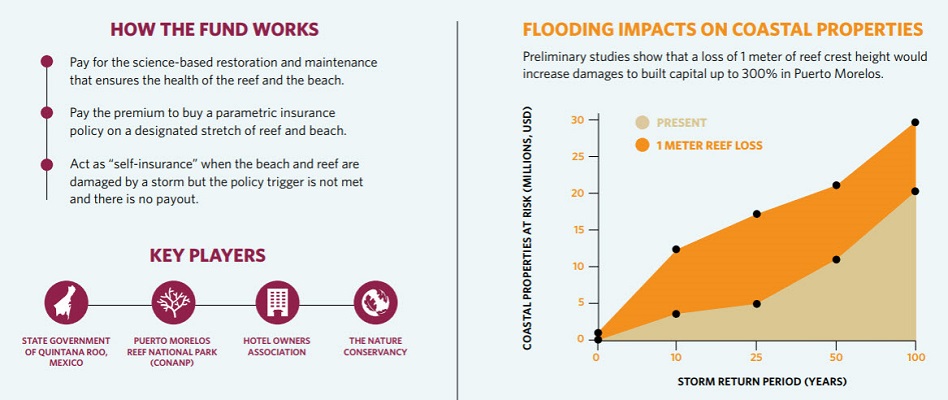Insuring Nature to Ensure a Resilient Future
What’s happening on a 60-kilometer stretch of coastline on Mexico’s Yucatan peninsula may change how the world values its coral reefs.
Read the entire article at The Nature Conservancy.
In 2005, Mexico’s Caribbean coast was struck by two hurricanes, causing USD$8 billion in damages and closing hotels and other businesses in Cancún long enough to cause further economic impact. But some hotels and beaches in Puerto Morelos suffered less damage than other areas in the state of Quintana Roo. Further analysis pointed to an important connection—Puerto Morelos was protected by an intact stretch of the Mesoamerican coral reef system.
This discovery has implications for the estimated 840 million people around the world who live with the risk of coastal flooding. For these coastal communities, natural systems like coral reefs, beaches and wetlands provide the first line of defense against storms. In fact, a healthy coral reef can reduce up to 97 percent of a wave’s energy before it hits the shore.
But coral reefs can themselves be damaged by severe storms (especially those that have already been weakened by pollution, disease, overfishing and bleaching) greatly reducing the protection they offer for coastal communities. In Mexico’s state of Quintana Roo, state government, hotel owners, The Nature Conservancy and the local science community are piloting an innovative strategy to confront this threat. This partnership has established a Coastal Zone Management Trust that will finance ongoing maintenance of reefs and beaches and purchase insurance to ensure these vital ecosystems are restored after extreme storms hit.
The Coastal Zone Management Trust was developed by the State Government of Quintana Roo in Mexico, The Nature Conservancy (TNC) and partners in the science community. More than two years in the making, the trust will be executed in partnership with the government and with support from The Rockefeller Foundation.
The trust will receive taxes, collected by the tourism industry, that can be used to fund maintenance and restoration efforts for 60 kilometers of reef and beaches in the Cancun and Puerto Morelos areas. In addition to funding ongoing conservation work, the trust will also be used to purchase an insurance policy.
The insurance is triggered when severe weather hits the area of reef, as reefs can be damaged in when wind speeds exceed approximately 100knots. The released funds can then be used for restoration activities to help the reef recover, and return to its full protective capacity, more quickly.
This innovative funding system will help to protect a $10 billion tourism industry; bolster economic resilience of the region; encourage conservation of a valuable natural asset; and create a scalable new market for the insurance industry — a model which could be applied to other regions and ecosystems.


